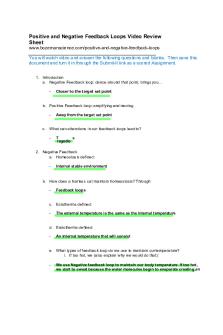Answers for Feedback Loops glucose and glucagon PDF

| Title | Answers for Feedback Loops glucose and glucagon |
|---|---|
| Course | Foundations of veterinary science |
| Institution | University of Sydney |
| Pages | 2 |
| File Size | 55.7 KB |
| File Type | |
| Total Downloads | 98 |
| Total Views | 154 |
Summary
Download Answers for Feedback Loops glucose and glucagon PDF
Description
Answers for Feedback Loops: Glucose and Glucagon Q. 1. Stimuli 1- After meals the body is said to be in an absorptive state as it absorbs nutrients from the gut .Blood –glucose levels rise (although this is buffered by glucose storage in the liver) Stimuli 2- when digestion is complete and the absorption of nutrients deceases, the body is in post –absorptive state and, as the body’s cells use glucose to make energy, blood – glucose levels fall. Q.2. In the absorptive state, an increase in blood glucose is detected by the beta cells of the pancreatic islets, causing them to increase the release of insulin into the blood. In term it will trigger the conversion of glucose into glycogen in the liver. Insulin stimulates cells, especially adipose and muscle cells, to take up glucose from the blood. Q.3. Glucagon being released by the alpha cells of the pancreas. The role of glucagon Glucagon has the opposite effect to insulin in that it increases blood-glucose levels and promotes processes that spare glucose utilisation. Convert stored glycogen into glucose and release it into the blood. Promote gluconeogenesis, the manufacture of new glucose from lactic acid and other metabolites. Q.4. Beta cells in the pancreas released the Insulin. Insulin stimulates cells, especially adipose and muscle cells, to take up glucose from the blood. The hormone also has other effects on the body’s cells, all of which contribute to an increase in glucose usage and storage - and therefore a reduction in blood glucose. Q.5. 4.0 to 5.4 mmol/L(72to 99mg/100ml) Q..6. Having too much sugar in the blood for long periods of time can cause serious health problems if it's not treated. Hyperglycemia can damage the vessels that supply blood to vital organs, which can increase the risk of heart disease and stroke, kidney disease, vision problems, and nerve problems. These problems don't usually show up in kids or teens who have had the disease for only a few years. But they can happen in adulthood in some people with diabetes, particularly if they haven't managed or controlled their diabetes well. 120mg/100ml 0r 6.67mmol/L is at the top end of non-diabetic range . Q.7. Low blood sugar (hypoglycaemia) for a diabetic treatment will be : Drink 15ml of fast acting carbohydrates Take 3-4 glucose tablets 4-6 candy pieces or 1 tbs of honey Q.8. The pancreas, a large gland that nestles under the stomach, plays an important part in glucose regulation and help to maintain the homeostasis. Q9. Once the carbohydrates digested and released into blood as glucose it will be used immediately as energy source or stored as fate for later use.
.10 Use the flow chart in your text book to explain how the negative feedback to maintain your home’s temperature....
Similar Free PDFs

Loops
- 1 Pages

VBScript For Loops - dsddsd
- 2 Pages

Froot Loops
- 6 Pages

Chapter 05 - Loops and Files
- 4 Pages

Feedback and Revision Reflection
- 2 Pages

RISE Model for Peer Feedback
- 1 Pages

Glucagon - drug sheet
- 3 Pages

Coding Bat Java For While Loops
- 7 Pages

Loopsin Java - Loops in Java
- 9 Pages
Popular Institutions
- Tinajero National High School - Annex
- Politeknik Caltex Riau
- Yokohama City University
- SGT University
- University of Al-Qadisiyah
- Divine Word College of Vigan
- Techniek College Rotterdam
- Universidade de Santiago
- Universiti Teknologi MARA Cawangan Johor Kampus Pasir Gudang
- Poltekkes Kemenkes Yogyakarta
- Baguio City National High School
- Colegio san marcos
- preparatoria uno
- Centro de Bachillerato Tecnológico Industrial y de Servicios No. 107
- Dalian Maritime University
- Quang Trung Secondary School
- Colegio Tecnológico en Informática
- Corporación Regional de Educación Superior
- Grupo CEDVA
- Dar Al Uloom University
- Centro de Estudios Preuniversitarios de la Universidad Nacional de Ingeniería
- 上智大学
- Aakash International School, Nuna Majara
- San Felipe Neri Catholic School
- Kang Chiao International School - New Taipei City
- Misamis Occidental National High School
- Institución Educativa Escuela Normal Juan Ladrilleros
- Kolehiyo ng Pantukan
- Batanes State College
- Instituto Continental
- Sekolah Menengah Kejuruan Kesehatan Kaltara (Tarakan)
- Colegio de La Inmaculada Concepcion - Cebu






